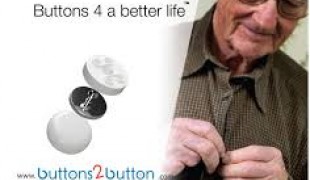- 7092
- 495
- 6
- 6
- 0
- Help Ukraine
About the solution
This innovation was thought of primarily for deadbolt handles, which are sometimes challenging for people with arthritis. It is a simple device made of a piece of wood, a piggy bank cap, and a small metal rod. In order to make it, you just need to use hot glue to attach the bank cap to the piece of wood and, then, make a small drill on the other end of the piece to attach the metal rod. This is a cheap, easy to make option for those who have trouble in opening or closing doors with small handles. Check the pictures, which can help you in the process.
Adapted from: http://bit.ly/2jLlink
This solution shall not include mention to the use of drugs, chemicals or biologicals (including food); invasive devices; offensive, commercial or inherently dangerous content. This solution was not medically validated. Proceed with caution! If you have any doubts, please consult with a health professional.
DISCLAIMER: This story was written by someone who is not the author of the solution, therefore please be advised that, although it was written with the utmost respect for the innovation and the innovator, there can be some incorrect statements. If you find any errors please contact the patient Innovation team via info@patient-innovation.com
-
-
441
-
7
-
7316

Woman creates magnetic buttons to help stepfather who has Parkinson's disease get dressed
(SELF)-CARE: DRESSING: Dressing independently.
Grip
CAREGIVING
Parkinson's Disease
Multiple Sclerosis
Bone Disorders (Decalcification, Bone Deformity, Bone Fracture, Bone Infection)
diabetes type 2
Assistive Daily Life Device (to help ADL)
Body-Worn solutions (Clothing, accessories, shoes, sensors...)
Muscle weakness
Tremors
Difficulty coordinating movements
Stiffness or rigidity (difficulty moving)
Limited range of motion
Muscle pain or stiffness
Loss of balance
Reduced grip force (grip)
Trouble with fine motor skills (e.g., writing, buttoning clothes)
Loss of muscle coordination
Muscle cramps or spasms
Joint deformity
Muscle twitching
Numbness or tingling in the extremities
Joint pain or swelling
Promoting self-management
Managing Neurological Disorders
Promoting inclusivity and social integration
Caregiving Support
Endocrinology
Neurology
Orthopedics
Rheumatology
United States
-
-
-
485
-
1
-
6989

Teenager develops tech to help himself and other disabled patients
CAREGIVING
Polio
Scoliosis
Paralysis
Assistive Daily Life Device (to help ADL)
Tremors
Difficulty coordinating movements
Stiffness or rigidity (difficulty moving)
Paralysis of the legs and lower body
Trouble with fine motor skills (e.g., writing, buttoning clothes)
Restoring mobility
Replacing lost limbs
Promoting self-management
Caregiving Support
Infectious Diseases
Neurology
Orthopedics
Rheumatology
Viet Nam
-
-
-
762
-
0
-
13617

MagnaReady® - adaptative clothing for people who struggle with fine motor skills
Grip
CAREGIVING
Parkinson's Disease
Body-Worn solutions (Clothing, accessories, shoes, sensors...)
Assistive Daily Life Device (to help ADL)
Tremors
Stiffness or rigidity (difficulty moving)
Trouble with fine motor skills (e.g., writing, buttoning clothes)
Promoting self-management
Managing Neurological Disorders
Promoting inclusivity and social integration
Caregiving Support
Internal Medicine
Neurology
Physical Medicine and Rehabilitation
Rheumatology
United States
-
 en
en